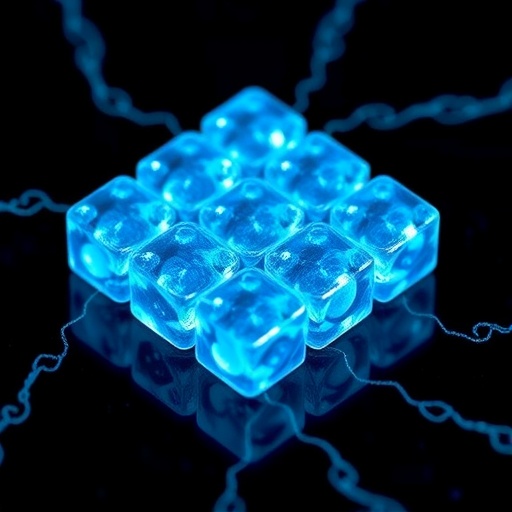In a groundbreaking advancement for the field of energy storage, researchers have begun fabricating and characterizing a novel polymer electrolyte using polyacrylonitrile (PAN) combined with sodium thiocyanate (NaSCN) for solid-state sodium-ion batteries. As energy storage technology continues to evolve, sodium-ion batteries have gained significant attention due to their potential as an alternative to traditional lithium-ion systems. With the global demand for energy storage solutions on the rise, this innovative approach could pave the way for enhanced battery performance, safety, and environmental sustainability.
The process of creating a polymer electrolyte from PAN is pivotal, as this material possesses a unique combination of mechanical and electrochemical properties that are favourable for battery applications. PAN is well-known for its stability and ability to form strong networks, which can facilitate ion conduction. The incorporation of NaSCN not only enhances ionic conductivity but also contributes to the thermal and electrochemical stability of the resulting electrolyte. This could prove vital for the efficiency and longevity of sodium-ion batteries, particularly in dynamic applications where temperature fluctuations are common.
One of the core aspects of this research focuses on the characterization of the polymer electrolyte to determine its suitability as a bridge for ion transport. The researchers employed various analytical techniques, such as Fourier-transform infrared spectroscopy (FTIR), to examine the chemical structure and interactions between PAN and NaSCN. These techniques provide crucial information about the bonding mechanisms at play, which ultimately influence the ionic conductivity of the electrolyte. Enhanced understanding of these interactions allows researchers to optimize the composition of the polymer electrolyte, leading to improved performance metrics.
Furthermore, the study investigates the effects of various concentrations of NaSCN on the ionic conductivity of the polymer electrolyte. As the concentration of NaSCN increases, a corresponding increase in ionic conductivity is observed, suggesting that there is an optimal range for ion transport that maximizes efficiency. This finding underscores the necessity for precise material formulation to strike a balance between conductivity and mechanical integrity.
Another significant aspect of the research is the evaluation of the thermal stability of the polymer electrolyte. Thermal performance is crucial, especially for applications that involve extensive charge and discharge cycles. Differential scanning calorimetry (DSC) tests reveal that the incorporation of NaSCN bolsters the thermal stability of the electrolyte. This means that batteries utilizing this novel electrolyte could operate safely and effectively under a wider range of temperatures, significantly reducing the risks associated with overheating.
The mechanical properties of the polymer electrolyte are equally important as they determine the durability and longevity of the battery. Tensile strength tests indicate that the bonds formed within the PAN-NaSCN matrix provide sufficient mechanical support, essential for the maintenance of structural integrity under operational stresses. This component of the research ensures that the batteries can withstand repeated charging cycles without degradation, a critical factor in commercial viability.
In assessing the overall electrochemical performance, researchers conducted galvanostatic charge-discharge tests, which provide a real-world view of the battery’s functionality. These tests demonstrated that batteries utilizing the new polymer electrolyte exhibited commendable cycle stability and efficiency, often outperforming conventional sodium-ion battery configurations. Enhanced cycle life translated into improved cost-effectiveness and sustainability, both of which are essential characteristics for next-generation energy storage solutions.
Moreover, the environmental implications of using sodium-ion technology cannot be overlooked. Sodium is abundant and inexpensive in comparison to lithium, making it a more sustainable resource for large-scale battery production. This shift not only addresses the current challenges related to lithium supply chains but also aligns with global efforts to establish more sustainable energy practices. The development of sodium-ion batteries represents a potential solution to alleviate resource depletion concerns while providing effective energy storage solutions.
In addition, the study emphasizes the versatility of the PAN-NaSCN electrolyte in relation to different battery architectures. Researchers speculate that this polymer electrolyte could be integrated into various configurations, including prismatic, cylindrical, and pouch cells, broadening its applicability across a spectrum of energy storage systems. This versatility is a valuable characteristic that can facilitate faster adoption in the market, allowing manufacturers to leverage this technology within their existing frameworks.
As the field of solid-state batteries continues to evolve, the integration of advanced polymers and alternative materials like sodium thiocyanate remains an area of intense study. The ongoing research undertaken by this team contributes to a growing body of literature that seeks to unlock the true potential of solid-state sodium-ion batteries. By focusing on material fabrication and characterization, the researchers are laying the groundwork for future innovations that could redefine energy storage technology.
Looking ahead, the implications of this research extend beyond laboratory findings—the potential applications in various industries are expansive. From electric vehicles to renewable energy systems, the enhanced performance of sodium-ion batteries equipped with this newly developed polymer electrolyte could revolutionize multiple sectors. This aligns with the broader objective of advancing sustainable practices in energy storage and consumption across the globe.
In conclusion, the fabrication and characterization of a polymer electrolyte based on polyacrylonitrile and sodium thiocyanate signifies a promising stride toward efficient and sustainable energy storage solutions. As the world transitions towards greener technologies, research like this underscores the importance of exploring alternative materials and innovative techniques to overcome current limitations in battery technology. The findings present opportunities not only for enhanced battery performance but also for addressing pressing environmental concerns, setting the stage for the next generation of energy storage systems.
Subject of Research: Development of polymer electrolytes for solid-state sodium-ion batteries.
Article Title: Fabrication and characterization of polymer electrolyte based on PAN with NaSCN for solid-state sodium-ion batteries.
Article References:
Shamimabanu, N., Selvanayagam, S., Selvasekarapandian, S. et al. Fabrication and characterization of polymer electrolyte based on PAN with NaSCN for solid-state sodium-ion batteries.
Ionics (2025). https://doi.org/10.1007/s11581-025-06549-x
Image Credits: AI Generated
DOI: https://doi.org/10.1007/s11581-025-06549-x
Keywords: Solid-state batteries, sodium-ion technology, polymer electrolytes, PAN, NaSCN, energy storage, electrochemical performance, mechanical properties, thermal stability, sustainable technology.




